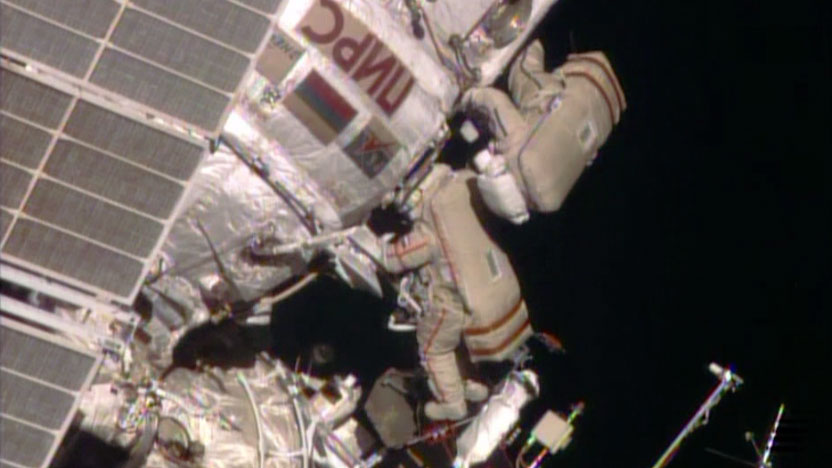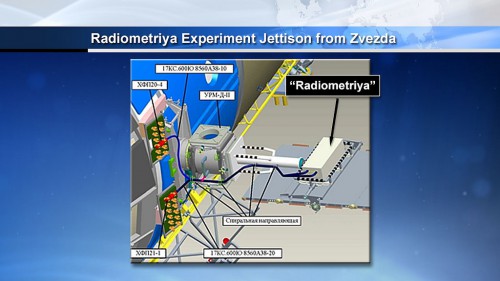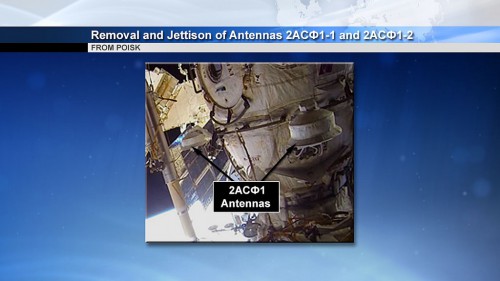
For the seventh time in 2014—and the third occasion in less than three weeks—a pair of spacewalkers toiled outside the International Space Station (ISS) earlier today (Wednesday, 22 October). Expedition 41 Commander Max Surayev and Flight Engineer Aleksandr Samukutyayev worked briskly for three hours and 38 minutes to remove and discard a scientific experiment package and a pair of unneeded rendezvous antennas, collect samples from the exterior of the Russian Orbital Segment (ROS), and conduct a comprehensive photo-documentation task. Today’s EVA marked the second career excursion for both Surayev and Samokutyayev and is expected to be the final ISS spacewalk of the year.
It has been an exciting and dramatic 2014 for EVAs, which kicked off on 27 January when Expedition 39 cosmonauts Oleg Kotov and Sergei Ryazansky spent six hours mounting a pair of high-fidelity cameras outside the space station. Next, on 23 April, astronauts Rick Mastracchio and Steve Swanson embarked on a 96-minute EVA—one of the shortest in U.S. spacewalking history—to replace a failed backup Multiplexer-Demultiplexer (MDM) on the expansive truss structure. First-time spacewalkers Aleksandr Skvortsov and Oleg Artemyev then supported a pair of EVAs on 19 June and 18 August to service external experiments, install new telemetry apparatus, fit and relocate experiments, and examine the condition of sections of multi-layered insulation. Most recently, astronauts Reid Wiseman, Alexander Gerst, and Barry “Butch” Wilmore executed a pair of EVAs on 7 October and 15 October to move a failed ammonia cooling pump to a long-term storage location, install a new Mobile Transporter Relay Assembly (MTRA), and replace a failed Sequential Shunt Unit (SSU) on the starboard truss.
Clad in bulky Orlan-MK (“Sea Eagle”) space suits, with Surayev designated “EV1” and bearing red stripes for identification, and Samokutyayev (“EV2”) sporting blue stripes, the two cosmonauts departed the station’s Pirs module at 9:28 a.m. EDT Wednesday, 22 October, to begin the fourth Russian EVA and the seventh overall EVA from the ISS in 2014. Used aboard the station by Russian spacewalkers since 2009, the Orlan-MK weighs 265 pounds (120 kg) and carries sufficient primary life-support consumables to sustain its wearer for at least seven hours, although no fewer than three Russian EVAs in the past 14 months have exceeded 7.5 hours in duration and one established an all-time Russian EVA record of eight hours and seven minutes.

Unlike the recent U.S. spacewalks, all of which featured at least one first-timer, both Surayev and Samokutyayev are seasoned EVA veterans. The former spent five hours and 44 minutes outside the ISS with Oleg Kotov in January 2010, during his stint on the Expedition 22 crew, whilst the latter embarked on a spacewalk of six hours and 23 minutes with Sergei Volkov in August 2011, during Expedition 28.
Working swiftly, Surayev and Samokutyayev moved to the Universal Work Platform (URM-D) and removed the 230-pound (105-kg) Radiometriya experiment, which has been in space since its delivery aboard Progress M-09M in February 2011. Designed to help scientists to better predict and respond to seismic events and earthquakes, Radiometriya has suffered from a power failure and after being detached the cosmonauts discarded it into space a little after 10 a.m. EDT, where it will shortly burn up in the atmosphere. Remaining at the URM-D worksite, Surayev and Samokutyayev pressed on with their next task: to remove a protective cover over the Expose-R experiment. The latter is part of an ongoing European Space Agency (ESA) investigation and seeks to expose biological and biochemical sample materials to the harsh radiation and near-vacuum conditions of low-Earth orbit. The cosmonauts photographed Expose-R and returned the cover to the Pirs airlock.
Whilst at Pirs, the cosmonauts collected tools, including an “EVA Knife”—actually a set of cable cutters—in support of their next work assignment. Surayev translated along the station’s Strela (“Arrow”) articulated boom to reach the Poisk module by about 10:40 a.m. EDT, where he and Samokutyayev set about removing a pair of unneeded Kurs-A (“Course”) navigation antennas. Impressive “helmet-cam” views showed Surayev working swiftly through the cutting of several cables in order to remove the antennas, each of which measured about 2 feet (0.6 meters) in length. By 11:05 a.m., Surayev had freed the first antenna, with the second following suit at 11:30 a.m., and both were jettisoned in an “aft” direction, in order to prevent recontact or impact with the ISS.

As the spacewalkers worked, their four Expedition 41 crewmates—U.S. astronauts Reid Wiseman and Barry “Butch” Wilmore, Russia’s fourth female cosmonaut, Yelena Serova, and Germany’s Alexander Gerst—were secluded in separate parts of the ISS, as a precautionary measure, in the dire event that they should be required to evacuate the station. Wilmore and Serova, who arrived with Samokutyayev on 25 September, were holed up in the Mini-Research Module (MRM)-2, whilst Wiseman and Gerst had free rein of the entire U.S. Orbital Segment (USOS) and Russia’s Zarya control module.
Upon completion of the Kurs-A removal task, Surayev and Samokutyayev undertook an extensive photographic survey of the Russian segment of the ISS, before cleaning up their respective work sites and returning to Pirs to conclude Wednesday’s EVA at 1:06 p.m. EDT, after three hours and 38 minutes. In finishing their second career spacewalks, Surayev has not totaled nine hours and 22 minutes outside the ISS, pipped slightly by Samokutyayev at 10 hours and one minute. Interestingly, the EVA marks the next leg in a little light-hearted rivalry between Samokutyayev and Wilmore. When Wilmore completed his first career EVA on 15 October, he established himself at 163rd on the list of 211 total spacewalkers, pushing Samokutyayev down to 164th place. Today’s EVA has allowed the Russian cosmonaut to not only move ahead of Wilmore, but also to move up an impressive 21 places to 145th on the list of the world’s most experienced spacewalkers. Max Surayev sits a little lower on the list, in 150th place. Today’s EVA also brings to 36 hours and 42 minutes the cumulative total time spent outside the ISS by astronauts and cosmonauts in 2014.
With no more EVAs scheduled this year from either the U.S. or Russian segments, 2015 promises to ratchet up the pace of spacewalks, with the scheduled arrival of the first International Docking Adapters (IDAs) for the long-awaited Commercial Crew vehicles. This will require a series of U.S. EVAs from January through to August. According to Space Station Integration Operations Manager Kenny Todd, two contingency EVAs last December and also a third unplanned spacewalk in April 2014 by Expedition 39’s Rick Mastracchio and Steve Swanson “had left some things out there that we knew we wanted put back in proper order.” He added that there was an urgent need to tend to power-related issues and improve the station’s fault-tolerant capability, ahead of several more complex EVAs next year.
Current plans call for two U.S. spacewalks in January 2015, two others in April and June, a pair in August, and another in the November/December timeframe to route cables and utilities in support of the relocation of the Leonardo Permanent Multipurpose Module (PMM) and the Pressurized Mating Adapter (PMA)-3. This will lay the groundwork for the delivery of two International Docking Adapters (IDAs) in support of Boeing’s CST-100 and SpaceX’s Dragon V2 Commercial Crew vehicles. The Leonardo PMM will be robotically transferred in July 2015 from the nadir port of the Unity node to the forward port of the Tranquility node, whilst PMA-3 will be moved in the late August timeframe from its current berth on Tranquility to the zenith port of the Harmony node for Commercial Crew operations. As for Russian EVAs, only one is currently planned, in June 2015.
Want to keep up-to-date with all things space? Be sure to “Like” AmericaSpace on Facebook and follow us on Twitter: @AmericaSpace



